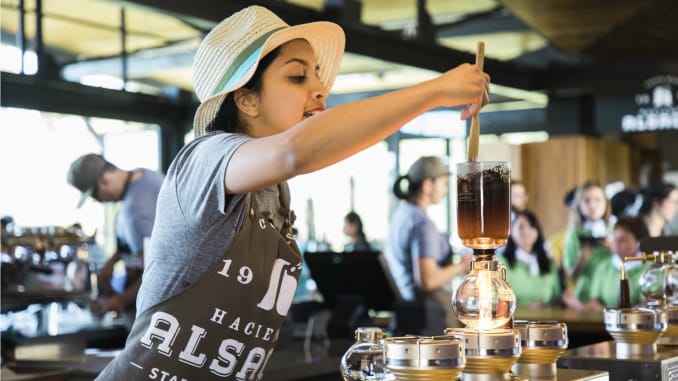Like the research conducted by Starbucks, the results will be shared with the public, WCR says.
WCR表示,和星巴克的研究一樣,屆時,他們也會共享他們的研究成果。
Individual retailers have invested in fighting climate change’s effect on their business as well.
個體零售商也在投資如何應對氣候變化對其業務的影響。
In El Salvador, Honduras and Nicaragua,
科瑞格(綠山)便在薩爾瓦多、洪都拉斯和尼加拉瓜三地
Keurig has funded a program to teach farmers how to implement new agricultural practices tailored for times when water availability is limited.
成立了教農民如何在水資源相對有限時開展其他種植活動的項目。
The program is an integral piece of the nearly $10 million the company spends annually to support farmers.
該公司每年都會投資近千萬美元扶持農民,上述項目便是該項投資的個中之一。
“When there are climate challenges in particular locations, we have the ability to source from other places,”
“個別地區面臨氣候挑戰時,我們還能從其他地方進貨,”
says Colleen Popkin, senior sustainability manager at Keurig.
科瑞格高級可持續發展經理科琳·波普金表示。
“Farmers don’t have that flexibility ...and those farmers are part of our long-term growth trajectory.”
“農民卻沒有這樣的選擇空間……而我們的長期增長又離不開這些農民。”
Illycafe takes a similar approach through what the company has termed the University of Coffee,
意利咖啡也做出了類似的舉措,對其項目的命名為“咖啡大學”,
a program with some 30,000 participants around the world.
該項目在世界各地已經有近3萬名參與者。
The initiative began in 1999 in Italy as a forum for a range of coffee professionals from baristas to growers looking to improve their business,
最初,這一舉措率先在意大利落地,時間是1999年,當時還只是為尋求改善業務的咖啡業從業者——包括從咖啡師到種植者在內的一系列人群——打造的一個論壇,
and since then has focused on helping farmers learn practices that will be sustainable in the face of a changing climate.
從那時起,該論壇就一直致力于幫助農民學習應對氣候變化的可持續應對方法。
The initiative trains thousands of farmers a year in more than 20 countries.
該項目每年培訓的農民多達數萬人,遍布20多個國家。
Training farmers sits at the “very center of our strategy,”
培訓農民是“我們戰略的一大核心”,

says Andrea Illy, chairman of Illycafe, who estimates that the coffee industry spends more than $100 million each year to adapt.
意利咖啡董事長安德里亞·意利說,據她估計,咖啡行業每年投入到適應氣候變化方面的資金高達1億美元以上。
But Illy says that number needs to multiply.
但意利表示,這個數字還需要翻倍。
“There is a huge gap,” he says.
“……存在一個巨大的缺口,”他說。
“The best educated guess is that in order to adapt to climate change,
“最合理的猜測是,為了適應氣候變化,
we would need as an overall industry to invest something like $1 billion per year to rejuvenate plantations,
就整個行業而言,要保持咖啡種植園的活力,開發新品種,改進設備,
develop new varieties, improve equipment, even migrate some coffee plantations.”
甚至遷移某些種植園,我們的年投入就需要10億美元左右。”
THE SWEET FRAGRANCE wafting through the air in the Costa Rican region of Naranjo, about 25 miles from the Starbucks farm, is unmistakable.
距離星巴克農場約25英里的哥斯達黎加納蘭喬地區的空氣中都清清楚楚地彌漫著一股香甜的氣息。
Bogantes Vargas and I are walking through a large coffee farm an hour’s drive from San José, the country’s capital, looking at blossoming flowers on coffee trees.
此時此刻,我和博甘蒂斯·瓦格斯正走在一片開闊的咖啡農場上,這里距離該國首都圣何塞一小時車程,看著咖啡樹上盛放的花朵。
As sweet as it smells, the odor from the plants is also unsettling.
盡管聞起來很甜,但也夾雜著一股令人不安的味道。
It’s early March, and the plants here should not bloom for weeks, Bogantes Vargas says.
現在才三月初,這些咖啡樹原本應該幾周后再開花的,博甘蒂斯·瓦格斯說。
The harvest from a plant that blooms too early could be lost for an entire season.
咖啡樹過早開花,整個種植季的收成都可能因此泡湯。



